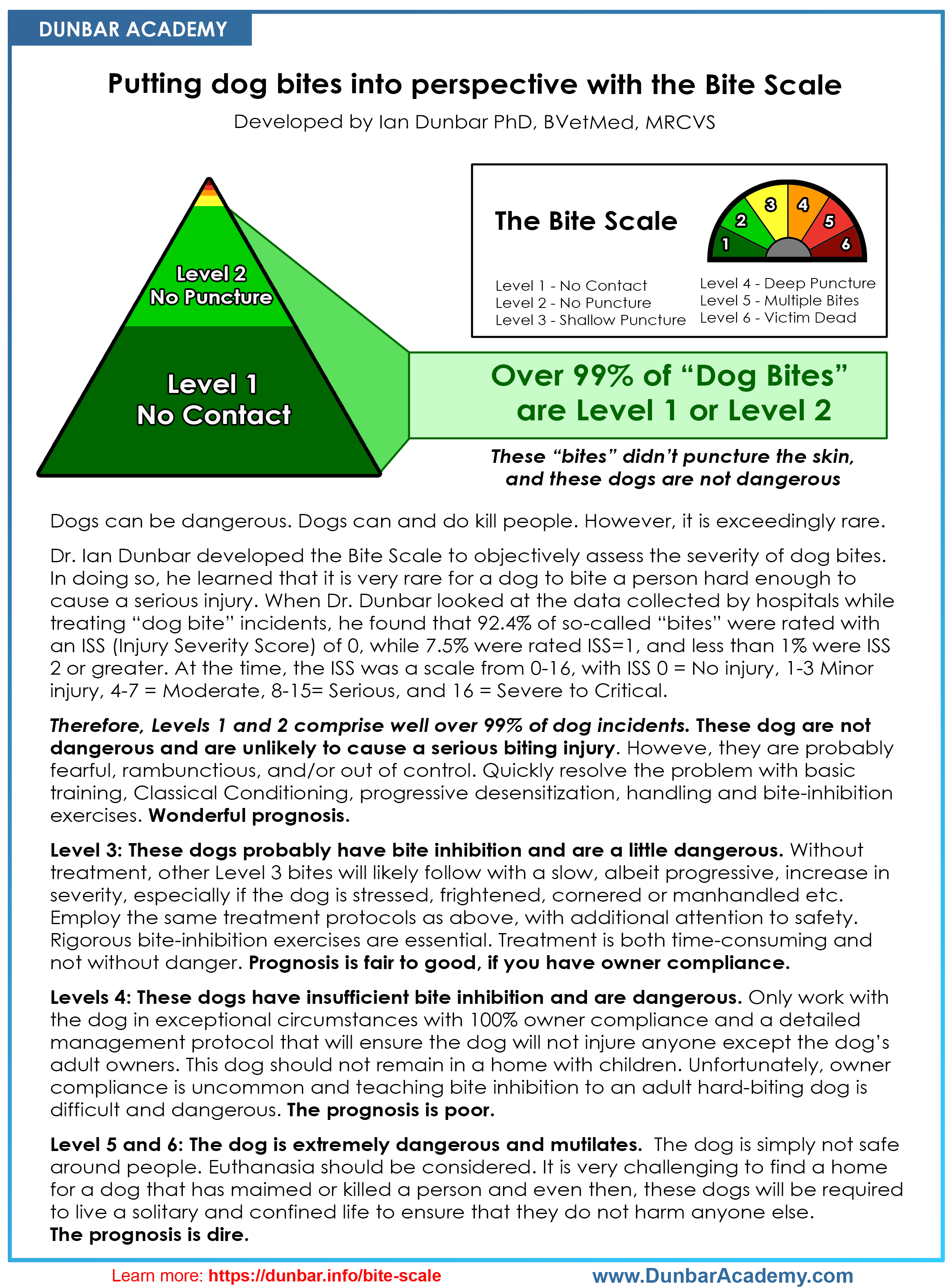Putting Dog Bites in Perspective
When you look at the numbers it becomes clear that most "biting dogs" can be rehabilitated safely
When you look at the data, only a small percentage of biting dogs are dangerous
Download the PDF version here:
You are welcome to share this document with anyone.
The Bite Scale was developed by Dr. Ian Dunbar as a tool for objectively assessing the severity of dog bites, because dog bites can be scary and emotional events and the descriptions provided by victims and witnesses can vary dramatically.
When Dr. Dunbar first developed the Bite Scale, he looked at the data collected by hospitals while treating "dog bite incidents."
What he found is that the majority of dog bites did not require any medical attention at all. Often, the dog's teeth didn't even contact the victim (Level 1), and when they did, they usually didn't break the skin or draw blood (Level 2).
These dogs are in desperate need of training and socialization so they don't bite anyone else in the future, but the good news is that these dogs can often be rehabilitated quickly and safely, because these dogs are unlikely to cause serious injuries in the future. For Level 1 and 2 biters, we strongly encourage you to enroll in the Top Dog Academy now, and make use of the many easy, effective, and safe training and socialization techniques.
For dogs that bite at Level 3 or above, it is likely that they will cause a similar, or more sever injury again in the future and so your first priority must be safety and managing your dog's environment and proximity to others in such a way that you can be sure that no one will get hurt.
Your next priority should be to immediately seek help from an Animal Behavior Consultant or Professional Dog Trainer who can evaluate your dog as an individual, ideally in-person.
To find a Certified Dog Trainer in your area, please consult the trainer-search databases of The International Association of Animal Behavior Consultants, or The Certification Council for Professional Dog Trainers. Both of these organizations have standards and accreditation requirements for all of their members.

Here is the text from the downloadable document above:
Dogs can be dangerous. Dogs can and do kill people. However, it is exceedingly rare.
Dr. Ian Dunbar developed the Bite Scale to objectively assess the severity of dog bites. In doing so, he learned that it is very rare for a dog to bite a person hard enough to cause a serious injury. When Dr. Dunbar looked at the data collected by hospitals while treating “dog bite” incidents, he found that 92.4% of so-called “bites” were rated with an ISS (Injury Severity Score) of 0, while 7.5% were rated ISS=1, and less than 1% were ISS 2 or greater. At the time, the ISS was a scale from 0-16, with ISS 0 = No injury, 1-3 Minor injury, 4-7 = Moderate, 8-15= Serious, and 16 = Severe to Critical.
Therefore, Levels 1 and 2 comprise well over 99% of dog incidents. These dog are not dangerous and are unlikely to cause a serious biting injury. Howeve, they are probably fearful, rambunctious, and/or out of control. Quickly resolve the problem with basic training, Classical Conditioning, progressive desensitization, handling and bite-inhibition exercises. Wonderful prognosis.
Level 3: These dogs probably have bite inhibition and are a little dangerous. Without treatment, other Level 3 bites will likely follow with a slow, albeit progressive, increase in severity, especially if the dog is stressed, frightened, cornered or manhandled etc. Employ the same treatment protocols as above, with additional attention to safety. Rigorous bite-inhibition exercises are essential. Treatment is both time-consuming and not without danger. Prognosis is fair to good, if you have owner compliance.
Levels 4: These dogs have insufficient bite inhibition and are dangerous. Only work with the dog in exceptional circumstances with 100% owner compliance and a detailed management protocol that will ensure the dog will not injure anyone except the dog’s adult owners. This dog should not remain in a home with children. Unfortunately, owner compliance is uncommon and teaching bite inhibition to an adult hard-biting dog is difficult and dangerous. The prognosis is poor.
Level 5 and 6: The dog is extremely dangerous and mutilates. The dog is simply not safe around people. Euthanasia should be considered. It is very challenging to find a home for a dog that has maimed or killed a person and even then, these dogs will be required to live a solitary and confined life to ensure that they do not harm anyone else. The prognosis is dire.
LEARN MORE
If you'd like to learn more about how to how to use dog training to prevent or resolve dog aggression and reactivity problems, join the Top Dog Academy to get access to ALL of our online courses, plus our private support community, for just $20/month.
Looking for more DADDs (Dunbar Academy Downloadable Documents)? You can find them here.
We have one all about how to use raw or wet food in training.